Alaska Fish & Wildlife News
July 2020
Hatchery Kings, Orphaned Bears
and the Necessity of Synergy in Conservation
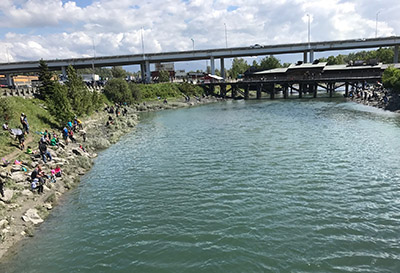
It is late June in Alaska’s largest city. Summer solstice, the longest day of the year; the date upon which the Northland’s moniker “land of the midnight sun” is most readily apparent. The inevitable and imperceptibly slow slide back towards the darkness of subarctic winter is far from the minds of Anchorage residents today. They, like Alaskans throughout the state, are celebrating the season. Celebrating by hiking and bicycling, camping and boating, picnicking and simply soaking up the sun. And, of course, by fishing.
Ship Creek, weaving its way past the warehouses and railyards of Anchorage’s industrial district, is a hive of activity. Anglers young, old, and from all walks of life gather on the banks and wet their line in hopes of a rendezvous with river royalty. Chinook salmon - “kings” in Alaskan parlance - ply these waters, surging in with the high tides as they begin the transition from the salty sea back to the freshwater of their conception. The whirring of dozens of spinning reels being cast fills the air, punctuated occasionally with cries of “fish on!” as those counted among the lucky begin the process of landing their catch.
Further upstream, keen-eyed observers may spot those salmon that have successfully run the gauntlet and escaped the human predation of the creek’s lower stretches. Here, shaded by the leaves and limbs of cottonwood trees, the fish hold in the deeper pools and eddies, biding their time until the eggs and testes inside their bodies fully develop and their coloration changes from the chrome camouflage of the ocean to the dull brick-red of a sexually mature king salmon.
That any of this is possible is due to the hard work of the Alaska Department of Fish and Game (ADF&G), Division of Sport Fish staff at the William Jack Hernandez Sport Fish Hatchery. Nestled along the north bank of Ship Creek just downstream from the old Elmendorf Power Plant dam, it is at this hatchery that these salmon began their lives. Part of a long-established, region-wide program designed to preserve and enhance angling opportunity through the establishment of reliable and accessible fisheries (thus alleviating pressures placed on wild stocks), these fish were raised under human care until their size and age dictated a readiness to make their own way in the world. Eager for the taste of saltwater, they were released into Ship Creek, drifting with the current to its mouth and the briny vastness beyond. Now, they have returned after spending one to six years at sea, evading commercial gillnets, anglers’ hooks, and a thousand manifestations of toothed death. The impetus for their return is a calling as old as the species itself: they have come home to begin the next generation.
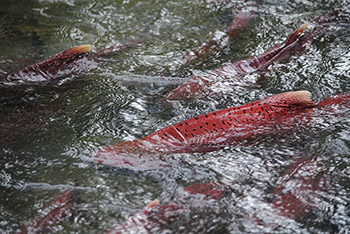
Everyone familiar with Pacific salmon is aware of their remarkable reproductive biology. After maturing in the open ocean, the fish migrate en masse to freshwater creeks, rivers, and streams, often to the very stretches where they themselves were hatched. Here they spawn, sowing the seeds of their species’ future, at times in scenes of such color and sheer numbers that stretch the limits of human imagination. These theatrics are part of the final act of their life’s narrative, however, as after their sole reproductive season all Pacific salmon invariably die. This seemingly tragic fact is not without ecological benefit, as the bodies of the dead salmon enrich the immediate environment; providing nutrients for the plankton and invertebrates that will feed next year’s salmon fry and fertilizing the plants that will shade and shelter them.
Salmon are, in a sense, creatures that give their own lives so that their offspring might flourish. In so doing, they enrich and even enable the livelihoods of a multitude of other organisms: predators, scavengers, and even the flora that line the riverbanks and make up the very landscape itself.
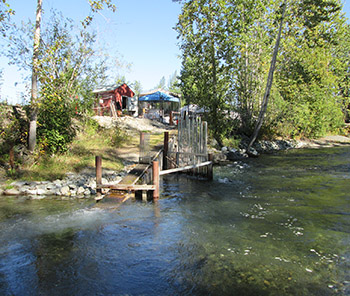
But what becomes of our Ship Creek kings, whose lives often end in the hands of hatchery staff, rather than the creek? What will be their denouement, their legacy?
To find the answer, we must return to the hatchery in a month’s time.
Ship Creek Raceways, Where the Ends of the Circle Meet
As anyone who has lived in the vicinity of the 60th parallel knows, July is among the busiest months of the year. Upon returning to Ship Creek a month after summer solstice, it is evident that the William Jack Hernandez Sport Fish Hatchery is not exempt from this seasonal schedule. Late in the month, the air at the hatchery is charged with a palpable and infectious energy. Today marks a highlight of the hatchery year, an annual event in which every member of the staff has a crucial role to play. As they ready buckets and totes and take up their positions along the raceways directly adjacent to Ship Creek, the scene takes on the camaraderie-rich, all-hands-on-deck atmosphere of a western roundup. Today marks the first king salmon egg take for the year.
Our Ship Creek kings have matured since we last saw them, their bodies darkened in spawning coloration. As the weeks have passed, more and more salmon have arrived at the outlet of the fish ladder leading to the raceways, holding nose-first in the current where the scent of the hatchery well water in which they were raised mingles with that of the creek. On the day when, a few weeks ago, weir poles were removed and access up the fish ladder was granted, many kings quickly shot up the ladder attempting to enter the raceways.
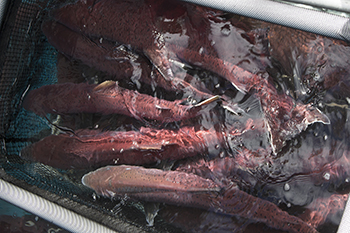
Upon reaching the top of the ladder - aided greatly by the special baffles outfitted within creating reverse vertices slowing the water’s flow – the salmon found themselves confronted by a small gate shaped in the manner of a “V”, with the point directly in their path of travel. The interlocking fingers comprising this gate gave way easily, and fish after fish poured through.
Crossing this threshold would be a one-way affair, however. Like the turnstiles at an amusement park, the finger weir allowed the fish to pass through, but not exit back the way they came. Faced with an impassable grate on one side and the finger weir on the other, our king salmon had no choice but to mill about in the queue, awaiting human assistance to pass over the grate and finally reach the raceways proper.
Ever since access up the fish ladder was granted, hatchery staff have come to the queue daily to physically hoist the kings over the crowding grate and into the raceways. In this way, they have been able to keep up-to-date records on fish numbers and sex ratios while being able to easily return any unneeded fish that may have swum up the ladder - such as wild pink salmon, which the hatchery does not raise – back to Ship Creek below. Physically holding each fish in their hands, staff have also been able to determine the relative ripeness of each female’s eggs by feeling the firmness of her belly. After many days or weeks of this process, the number of individual salmon accumulated within the raceways eventually reached a target threshold of 40-100 fish, enough to warrant a planned egg take.
That was a week ago, and with the fish having had sufficient time to “ripen” in the raceways and all necessary equipment now set up and in place, hatchery staff have begun the egg take in earnest. The process runs like a well-oiled machine.
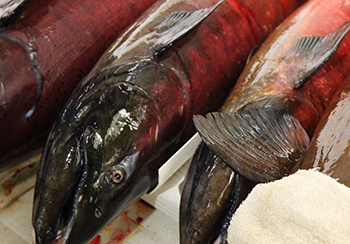
First, two or three staff members don waders and get into the raceways among the kings, sorting males from females and grabbing fish of the appropriate sex as they are needed. After being selected, each fish is quickly euthanized with a sharp blow to the head. While at first glance this may seem brutal, it is important to remember that no matter the circumstances, all Pacific salmon will die shortly after reaching reproductive maturity. When considering that the best-case natural death a salmon can face is slow decomposition, it becomes obvious that the hatchery staff’s method is as humane as it is efficient.
After a fish is dispatched, it is handed up to staff members who place it belly up alongside other salmon in a series of trays. Each fish is cleaned with a disinfectant and wiped down to remove any blood or mucus that could contaminate the gametes as they are collected. The bellies of the female salmon are then opened with a small blade and the eggs – 5,000 to 10,000 of them – are emptied into a bucket, looking for all the world like small, translucent globules of grapefruit marmalade. Complimentarily, the bellies of the male salmon are gently squeezed as they are held aloft, draining milt into carefully-aimed and labelled plastic bags.
After this process, the spawned carcasses of the adult fish are passed down a series of tables, along an assembly line from which data – the staff of life for biologists – can be collected: overall body length, otoliths for age determination, female kidney samples for disease screening, and snipped axillary processes for future genetics work. Once all appropriate measurements and samples have been gleaned from the kings, their bodies are laid to rest in the large plastic totes that mark the tail end of the egg take area.

The eggs and milt, meanwhile, are carried up to the hatchery building, where they will be sorted and then combined, initiating that ancient and mysterious alchemy as old as life itself. Over the next four months the progeny of our Ship Creek kings will incubate in trays of circulating water, the rooms darkened to simulate the murky lighting of a creek bed beneath a wintry ceiling of snow-covered ice. These unhatched salmon are destined to one day be released at locations throughout southcentral Alaska, places with evocative and storied names like Eklutna and Seward, Cordova and Whittier, Homer and Seldovia, and of course Ship Creek itself, where the cycle will begin again.
Today’s egg take has gone quite smoothly, and the work will soon wrap up for the afternoon. As the hatchery staff go about their duties, others whose lives are likewise tied closely to animals wait on the periphery, watching the totes fill with more and more kings, eager to shuttle these contents away from the hatchery and on to the next and final link in our salmons’ story.
Feeding Alaskans, Both Furred and Feathered
In the afternoon heat a brown bear lifts his head and inhales the slight breeze. A good-sized male in his sixteenth year of life, he rouses himself from his daybed tucked away in the shade of a willow thicket. Blinking a time or two as he peeks out from the brush, his eyes take a moment to adjust to the bright sunlight of this bluebird day. With his distinctive lopped right ear and swaggering gait, he cuts an impressive figure as he emerges into the open. Moving across the meadow he glances over at two other brown bears: his twin sister and a second, unrelated female with whom he shares this spacious enclosure. Known to Alaska Wildlife Conservation Center (AWCC) staff and visitors as “JB”, he takes a seat below the elevated viewing walkway and gazes up at the onlookers gathered there.
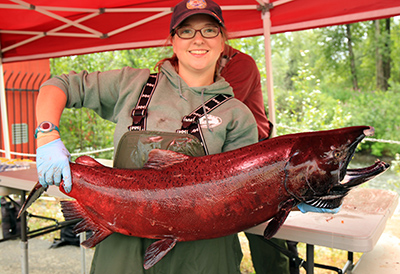
Through some unknown stimulus – the angle of the sun, the increased gathering of visitors on the viewing platform, perhaps even some inherent animal understanding of time that we do not yet fathom – the male bear knows that it is nearly time for his afternoon feeding, the second of three occurring daily. This meal, likely his favorite, is the one in which he knows he receives the largest proportion of animal protein. What he doesn’t know is that this afternoon he is in for a special treat. Today’s protein comes in the form of a fish, a large one that only yesterday was still swimming: one of our Ship Creek kings.
Within a handful of minutes, the AWCC staff in their recognizable uniforms arrive at the walkway. They work their way among the crowd of onlookers who appear as sharp-eyed and eager as the gulls and magpies that have also worked out the daily schedule and gather nearby in anticipation of the bears’ feeding. After a few words from the staff members, three salmon carcasses are tossed into the enclosure, each hitting the ground with a dull thud. Camera shutters click, gulls call loudly, and a staff member launches into an educational talk while the three brown bears below each enjoy their first whole king salmon of the year.
While there are a few different avenues that spawned hatchery salmon carcasses may follow after an egg take, a number of them are ultimately picked up by representatives from a handful of captive wildlife facilities in Anchorage and beyond. Both the Alaska Zoo and Alaska Wildlife Conservation Center are prime examples of organizations that have been beneficiaries of spawned hatchery carcasses. These two private, non-profit facilities house and care for a multitude of Alaskan wildlife species for public exhibition and education. Both black and brown bears are included in the two facilities’ collections, and it is to these bears that many of the salmon carcasses ultimately go.

Bears and salmon are closely linked in the public’s imagination, and rightfully so. Throughout most areas of south-coastal Alaska, spawning salmon are a primary food source for bears during times of seasonal abundance. Even in watersheds nestled deep in the interior of the state - along the Kobuk or Kantishna, for example – one can often find the tracks of a bear and small piles of polished fish bones marking the banks of those feeder streams where salmon come to breed.
Thus, it is no surprise that captive bears relish meals of Ship Creek kings, and the opportunity to provide them with this food source makes a winner out of all involved.
By the time of an egg take, the salmon are inherently in an advanced stage of physical maturation. Though no longer fit for human consumption, a degree of “ripeness” in these fish does not bother the bears at all, as evidenced by the gusto with which they tuck into their prizes. Feeding these carcasses to bears or other animals in captivity allows the fish to be utilized and prevents them from merely ending up as waste products, the disposal of which would not only be somewhat disheartening but also cost time and money.
Receiving whole salmon is not only beneficial to the bears gastronomically, but mentally as well. The act of consuming entire large fish is an enriching opportunity that adds variety to the diet and enlivens the feeding experience. It requires the bears to exercise their minds as well as their paws and jaws as they process the carcass themselves, and it provides what must be an ursine satisfaction of gulping flesh and crunching bones.
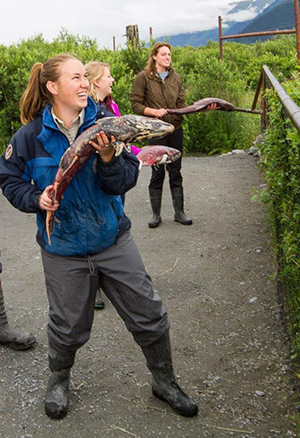
Satisfaction does not stop at the inner edge of the enclosure, however. Visitors fortunate enough to observe bears feeding on the hatchery kings are treated to a viewing experience both captivating and instructive. While of course there is a certain visceral thrill in watching a large bear tear into and consume a large fish, there is also undeniable educational value. All of a sudden, the concepts of bear feeding behavior, salmon ecology, and the intertwined nature of bear and salmon conservation take on a new relevance as they are being witnessed first-hand. One only has to be present at a bear feeding to see that even the most jaded onlooker cannot help but walk away with at least some newfound or renewed appreciation for bears, salmon, and the small miracles of nature.
It is not only the carcasses of spawned adult salmon that make their way from the hatchery. Rainbow trout, Arctic char, and salmon smolt from the hatchery’s “catchable” program that have succumbed to natural causes are often provided to Bird TLC, an educational organization in Anchorage that rehabilitates injured raptors and other birds and returns them back to the wild. For both the birds who seem to be good candidates for re-release and the human caretakers in charge of such decisions, having access to whole fish is important. Fish carcasses from the hatchery allow the birds to reacquaint themselves with processing and consuming whole prey items, and birds that are unable to do so may need to spend a bit more time recuperating or may in fact end up being better suited to remain in captivity as educational animals.
It is time spent in captivity, under human care, that is the common thread uniting the birds, bears, and fish we have discussed. The durations vary, but all have lived, at least for a time, in the world of mankind: the salmon initially raised within a hatchery before being released to make their way to the sea, the birds temporary residents as they recover from illness or injury, and the bears all orphaned in the wild at an early age and given permanent residence in the next best thing. With this in mind, the provision of these salmon to their natural predators takes on a new significance. It means that, despite having a portion of their lives in some way altered and deeply tied to humanity, humans have seen fit to provide these animals the opportunity to participate in the profound ecological relationships deeply rooted in the history of both the species themselves and the Alaskan landscape.
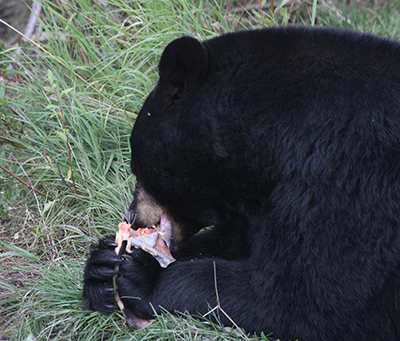
The significance of these relationships is made abundantly clear as JB the brown bear swallows the last few scraps composing all that remains of the salmon that minutes ago laid at his feet. July is nearing its end, and with autumn just around the corner, the bear’s appetite is beginning to grow. After sniffing the immediate vicinity to ensure that no morsels remain undetected, he saunters in the direction of the viewing walkway, from which a second gift from Ship Creek was cast moments ago, now sitting on the ground awaiting him.
Hitching it All Together
What, in the end, does all of this mean? In viewing the scene described above, one could be excused if they noted simply a bear eating a salmon - an interesting glimpse of the food chain in action, to be sure - but little more. What else could there really be to think about or comprehend?
The naturalist John Muir once wrote, “when we try to pick out anything by itself, we find it hitched to everything else in the Universe.” The resounding truths of this statement have often been applied to the natural world, and rightfully so. All of us are in some way aware of the interconnectivity of ecosystems and the organisms that comprise them. Much like an ecosystem, the conservation of fish and wildlife must be composed of a variety of different entities, each performing its own role and “hitched together” with others for a greater cumulative impact. These entities include government agencies that manage fish and wildlife generally at a state or federal level as well as the numerous and varied non-governmental organizations (NGOs) who direct their attention on a single species, landscape, or broader concept that the managerial agencies cannot solely focus on.
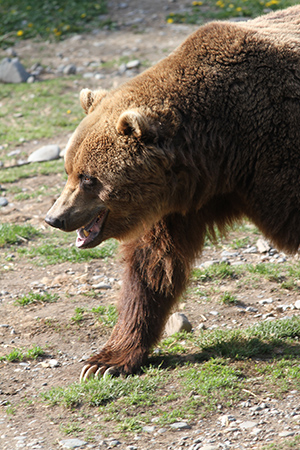
In the donation of fish carcasses to captive wildlife facilities, we are given a small example of a managerial agency (ADF&G) coming together with NGOs (the Alaska Zoo, AWCC, and Bird TLC) in order to accomplish shared goals; in this case, the utilization of a hatchery by-product in a manner that fosters public appreciation for both the missions of all organizations involved and for fish and wildlife generally.
Though the hatchery and various wildlife facilities have different stated missions (enhancement of sport fishing opportunities for one and public education through varying degrees of animal exhibition for the others) they ultimately share the same objective; chiefly, building a constituency for fish and wildlife and impressing upon their audiences the crucial importance of conservation action in order to ensure the continued existence of that fish and wildlife.
As the Anthropocene, the geologic “Age of Humanity”, continues its seemingly inexorable march, the future of fish and wildlife – in this state, on this continent, on this planet - will increasingly rely on the cooperation of those who have taken very different paths in order to arrive at the same destination. Will these conservationists with different viewpoints and motivations ultimately be able to work together? Of course they will be. When people gather together and focus on the perspectives that they share rather than those on which they differ, miraculous things can be accomplished.
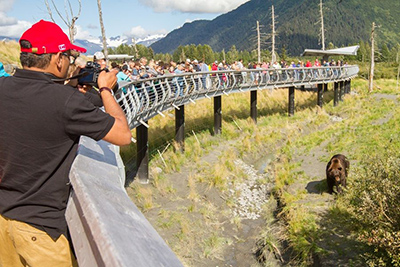
In a very small way, the journey of our Ship Creek kings - from hatchery, to ocean, to the belly of a bear - is proof of that.
Wilson Puryear is a seasonal Fish and Wildlife Technician at the Ship Creek Fisheries Center, located within the William Jack Hernandez Sport Fish Hatchery. A lifelong Alaskan, he has been fortunate enough to have also worked as an animal keeper at both the Alaska Zoo and Alaska Wildlife Conservation Center in the past.
___________________________________
A video depicting a Chinook salmon egg take at the William Jack Hernandez Sport Fish Hatchery can be found online at The Alaska Department of Fish and Game’s YouTube channel.
To learn more about ADF&G’s sport fish hatcheries, visit their homepage on the Department’s website.
For daily stocking updates, announcements regarding upcoming hatchery events, and information about Alaska’s sport fish enhancement program, follow the Ship Creek Fisheries Center on Facebook.
Subscribe to be notified about new issues
Receive a monthly notice about new issues and articles.
